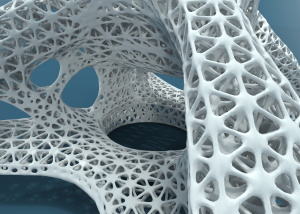This article appeared in our 2018 annual report. Click here to read the full document.
Generative design has moved into a new phase. CATIA Generative Design already uses automated shape design in modeling industrial components, drawing on pre-defined parameters that meet mechanical requirements and fit smoothly with other components. This automated process produces a totally unique, lightweight three-dimensional shape that offers extremely high performance and can only be made using 3D printing. And morphogenesis takes the generative capabilities even further.
Optimizing mass locally
Morphogenesis is the process by which living tissue and organs take shape. The Morphogenesis approach is inspired by two types  of structure observed in nature: lattice and trabecular (featuring small rods). One of the major advantages of the lattice structure is its strength. It produces a material that is very even and can support external force while retaining its tensile capacity. Trabecular structures are used to optimize mass locally, as the rods are aligned in the direction of force and stress. That is not the case with lattices, which feature a repeating pattern.
of structure observed in nature: lattice and trabecular (featuring small rods). One of the major advantages of the lattice structure is its strength. It produces a material that is very even and can support external force while retaining its tensile capacity. Trabecular structures are used to optimize mass locally, as the rods are aligned in the direction of force and stress. That is not the case with lattices, which feature a repeating pattern.
Read the full story in 3D Perspectives
Read more about generative design in our blog post, Why Generative Design Meeting 3D Printing is an Engineer’s Dream

